Strain Engineering of Anisotropic Electronic, Transport, and Photoelectric Properties in Monolayer Sn2Se2P4
Abstract
1. Introduction
2. Calculational Methods
2.1. Details of Structural Optimization and Electronic Structure
2.2. The Calculational Method for Carrier Transport Properties
2.3. Calculational Method for Photocurrent
3. Results and Discussion
3.1. Structural and Electronic Properties of Sn2Se2P4
3.2. Anisotropic I–V Characteristics
3.3. Uniaxial Strain-Modulated I–V Characteristics
3.3.1. a-Axis Strain-Modulated I–V Characteristics
3.3.2. b-Axis Strain-Modulated I–V Characteristics and NDC Effects
3.4. Photocurrent Transport Properties
4. Conclusions
Supplementary Materials
Author Contributions
Funding
Institutional Review Board Statement
Informed Consent Statement
Data Availability Statement
Acknowledgments
Conflicts of Interest
References
- Feng, X.; Cheng, R.; Yin, L.; Wen, Y.; Jiang, J.; He, J. Two-Dimensional Oxide Crystals for Device Applications: Challenges and Opportunities. Adv. Mater. 2024, 36, 2304708. [Google Scholar] [CrossRef] [PubMed]
- Hu, J.; Dong, M. Recent advances in two-dimensional nanomaterials for sustainable wearable electronic devices. J. Nanobiotechnol. 2024, 22, 63. [Google Scholar] [CrossRef] [PubMed]
- Jiang, J.; Xu, L.; Qiu, C.; Peng, L.-M. Ballistic two-dimensional InSe transistors. Nature 2023, 616, 470–475. [Google Scholar] [CrossRef] [PubMed]
- Joseph, S.; Mohan, J.; Lakshmy, S.; Thomas, S.; Chakraborty, B.; Thomas, S.; Kalarikkal, N. A review of the synthesis, properties, and applications of 2D transition metal dichalcogenides and their heterostructures. Mater. Chem. Phys. 2023, 297, 127332. [Google Scholar] [CrossRef]
- Qu, J.; Cheng, H.; Lan, H.; Zheng, B.; Luo, Z.; Yang, X.; Yi, X.; Wu, G.; Chen, S.; Pan, A. Space-Confined Growth of Ultrathin P-Type GeTe Nanosheets for Broadband Photodetectors. Small 2024, 20, 2309391. [Google Scholar] [CrossRef]
- Tang, X.; Hao, Q.; Hou, X.; Lan, L.; Li, M.; Yao, L.; Zhao, X.; Ni, Z.; Fan, X.; Qiu, T. Exploring and Engineering 2D Transition Metal Dichalcogenides toward Ultimate SERS Performance. Adv. Mater. 2024, 36, 2312348. [Google Scholar] [CrossRef]
- Wu, Y.; Yuan, W.; Xu, M.; Bai, S.; Chen, Y.; Tang, Z.; Wang, C.; Yang, Y.; Zhang, X.; Yuan, Y.; et al. Two-dimensional black phosphorus: Properties, fabrication and application for flexible supercapacitors. Chem. Eng. J. 2021, 412, 128744. [Google Scholar] [CrossRef]
- Xu, Y.; Li, D.; Sun, H.; Xu, H.; Li, P. Comprehensive understanding of electron mobility and superior performance in sub-10 nm DG ML tetrahex-GeC2 n-type MOSFETs. Phys. Chem. Chem. Phys. 2024, 26, 4284–4297. [Google Scholar] [CrossRef]
- Baglov, A.; Khoroshko, L.; Zhoidzik, A.; Dong, M.; Weng, Q.; Kazi, M.; Khandaker, M.U.; Islam, M.A.; Chowdhury, Z.Z.; Sayyed, M.I.; et al. Evolution of structural and electronic properties standardized description in rhenium disulfide at the bulk-monolayer transition. Heliyon 2024, 10, e28646. [Google Scholar] [CrossRef]
- Yamusa, S.A.; Shaari, A.; Alsaif, N.A.M.; Alsalamah, I.M.; Isah, I.; Rekik, N. Elucidating the Structural, Electronic, Elastic, and Optical Properties of Bulk and Monolayer MoS2 Transition-Metal Dichalcogenides: A DFT Approach. ACS Omega 2022, 7, 45719–45731. [Google Scholar] [CrossRef]
- Javaid, M.; Drumm, D.W.; Russo, S.P.; Greentree, A.D. A study of size-dependent properties of MoS2 monolayer nanoflakes using density-functional theory. Sci. Rep. 2017, 7, 9775. [Google Scholar] [CrossRef] [PubMed]
- Aparna, M.P.; Chatanathodi, R. Density Functional Theory Calculations of the Stability, Electronic Structure, and Magnetism of ReS2 Nanoribbons: An Emerging Material for Electrocatalytic Reactions. ACS Appl. Nano Mater. 2022, 5, 2385–2394. [Google Scholar] [CrossRef]
- Xu, Y.; Dai, J.; Zeng, X.C. Electron-Transport Properties of Few-Layer Black Phosphorus. J. Phys. Chem. Lett. 2015, 6, 1996–2002. [Google Scholar] [CrossRef] [PubMed]
- Xu, Y.; Long, Q.; Li, D.; Li, P. 2D Violet phosphorene with highly anisotropic mobility and its vdW heterojunction design for device applications. Phys. Chem. Chem. Phys. 2022, 24, 3379–3385. [Google Scholar] [CrossRef] [PubMed]
- Shim, J.; Oh, S.; Kang, D.-H.; Jo, S.-H.; Ali, M.H.; Choi, W.-Y.; Heo, K.; Jeon, J.; Lee, S.; Kim, M.; et al. Phosphorene/rhenium disulfide heterojunction-based negative differential resistance device for multi-valued logic. Nat. Commun. 2016, 7, 13413. [Google Scholar] [CrossRef]
- Kaneko, S.; Tsuchiya, H.; Kamakura, Y.; Mori, N.; Ogawa, M. Theoretical performance estimation of silicene, germanene, and graphene nanoribbon field-effect transistors under ballistic transport. Appl. Phys. Express 2014, 7, 035102. [Google Scholar] [CrossRef]
- Devi, P.K.; Singh, K.K. Electronic and work function-based glucose sensors on graphene, silicene, and germanene sheets—DFT studies. Comput. Theor. Chem. 2023, 1225, 114134. [Google Scholar] [CrossRef]
- Gueorguiev, G.K.; Stafström, S.; Hultman, L. Nano-wire formation by self-assembly of silicon–metal cage-like molecules. Chem. Phys. Lett. 2008, 458, 170–174. [Google Scholar] [CrossRef]
- Filho, M.A.M.; Farmer, W.; Hsiao, C.-L.; dos Santos, R.B.; Hultman, L.; Birch, J.; Ankit, K.; Gueorguiev, G.K. Density Functional Theory-Fed Phase Field Model for Semiconductor Nanostructures: The Case of Self-Induced Core–Shell InAlN Nanorods. Cryst. Growth Des. 2024, 24, 4717–4727. [Google Scholar] [CrossRef]
- Shockley, W.; Queisser, H.J. Detailed Balance Limit of Efficiency of p-n Junction Solar Cells. J. Appl. Phys. 1961, 32, 510–519. [Google Scholar] [CrossRef]
- Park, N.-G.; Segawa, H. Research Direction toward Theoretical Efficiency in Perovskite Solar Cells. ACS Photonics 2018, 5, 2970–2977. [Google Scholar] [CrossRef]
- Rühle, S. Tabulated values of the Shockley–Queisser limit for single junction solar cells. Sol. Energy 2016, 130, 139–147. [Google Scholar] [CrossRef]
- Xu, Z.-H.; Jiang, J.; Wang, Z.; Wei, K.; Liu, G.; Ke, S.-H. Tunable electronic and optoelectronic characteristics of two-dimensional g-GeC monolayer: A first-principles study. Opt. Express 2024, 32, 40539–40553. [Google Scholar] [CrossRef]
- Liao, L.; Lin, Y.-C.; Bao, M.; Cheng, R.; Bai, J.; Liu, Y.; Qu, Y.; Wang, K.L.; Huang, Y.; Duan, X. High-speed graphene transistors with a self-aligned nanowire gate. Nature 2010, 467, 305–308. [Google Scholar] [CrossRef]
- Ares, P.; Cea, T.; Holwill, M.; Wang, Y.B.; Roldán, R.; Guinea, F.; Andreeva, D.V.; Fumagalli, L.; Novoselov, K.S.; Woods, C.R. Piezoelectricity in Monolayer Hexagonal Boron Nitride. Adv. Mater. 2020, 32, 1905504. [Google Scholar] [CrossRef]
- Li, P.; Wu, W.; Xu, Y.; Liu, J.; Wu, S.; Ye, Y.; Liang, C.; Zeng, X.C. Two-Dimensional IV–V Monolayers with Highly Anisotropic Carrier Mobility and Electric Transport Properties. J. Phys. Chem. Lett. 2021, 12, 1058–1065. [Google Scholar] [CrossRef] [PubMed]
- Conley, H.J.; Wang, B.; Ziegler, J.I.; Haglund, R.F., Jr.; Pantelides, S.T.; Bolotin, K.I. Bandgap Engineering of Strained Monolayer and Bilayer MoS2. Nano Lett. 2013, 13, 3626–3630. [Google Scholar] [CrossRef]
- Laurien, M.; Saini, H.; Rubel, O. Band alignment of monolayer CaP3, CaAs3, BaAs3 and the role of p–d orbital interactions in the formation of conduction band minima. Phys. Chem. Chem. Phys. 2021, 23, 7418–7425. [Google Scholar] [CrossRef] [PubMed]
- Jalil, A.; Zhuo, Z.; Sun, Z.; Wu, F.; Wang, C.; Wu, X. A phosphorene-like InP3 monolayer: Structure, stability, and catalytic properties toward the hydrogen evolution reaction. J. Mater. Chem. A 2020, 8, 1307–1314. [Google Scholar] [CrossRef]
- Jing, Y.; Ma, Y.; Li, Y.; Heine, T. GeP3: A Small Indirect Band Gap 2D Crystal with High Carrier Mobility and Strong Interlayer Quantum Confinement. Nano Lett. 2017, 17, 1833–1838. [Google Scholar] [CrossRef]
- Tang, P.; Yuan, J.-H.; Song, Y.-Q.; Xu, M.; Xue, K.-H.; Miao, X.-S. BaAs3: A narrow gap 2D semiconductor with vacancy-induced semiconductor–metal transition from first principles. J. Mater. Sci. 2019, 54, 12676–12687. [Google Scholar] [CrossRef]
- Xie, M.; Li, Y.; Liu, X.; Yang, J.; Li, H.; Li, X.a. Two-dimensional IV–VA3 monolayers with enhanced charge mobility for high-performance solar cells. Phys. Chem. Chem. Phys. 2022, 24, 20694–20700. [Google Scholar] [CrossRef]
- Sun, S.; Meng, F.; Wang, H.; Wang, H.; Ni, Y. Novel two-dimensional semiconductor SnP3: High stability, tunable bandgaps and high carrier mobility explored using first-principles calculations. J. Mater. Chem. A 2018, 6, 11890–11897. [Google Scholar] [CrossRef]
- Zhu, Y.-L.; Yuan, J.-H.; Song, Y.-Q.; Xue, K.-H.; Wang, S.; Lian, C.; Li, Z.-N.; Xu, M.; Cheng, X.-M.; Miao, X.-S. Promising photocatalysts with high carrier mobility for water splitting in monolayer Ge2P4S2 and Ge2As4S2. Int. J. Hydrogen Energy 2019, 44, 21536–21545. [Google Scholar] [CrossRef]
- Liu, Y.-L.; Jiang, X.-X.; Li, B.; Shi, Y.; Liu, D.-S.; Yang, C.-L. First principles study of photoelectrochemical water splitting in monolayer Sn2S2P4 with high solar-to-hydrogen efficiency. Appl. Phys. Lett. 2021, 119, 143102. [Google Scholar] [CrossRef]
- Trung, P.D.; Tong, H.D. First principles study of strain effects on prospective 2D photocatalysts Sn2Se2X4 (X = P, As) with ultra-high charge carrier mobility. Phys. Chem. Chem. Phys. 2024, 26, 4437–4446. [Google Scholar] [CrossRef]
- Smidstrup, S.; Stradi, D.; Wellendorff, J.; Khomyakov, P.A.; Vej-Hansen, U.G.; Lee, M.-E.; Ghosh, T.; Jónsson, E.; Jónsson, H.; Stokbro, K. First-principles Green's-function method for surface calculations: A pseudopotential localized basis set approach. Phys. Rev. B 2017, 96, 195309. [Google Scholar] [CrossRef]
- Smidstrup, S.; Markussen, T.; Vancraeyveld, P.; Wellendorff, J.; Schneider, J.; Gunst, T.; Verstichel, B.; Stradi, D.; Khomyakov, P.A.; Vej-Hansen, U.G.; et al. QuantumATK: An integrated platform of electronic and atomic-scale modelling tools. J. Phys. Condens. Matter 2020, 32, 015901. [Google Scholar] [CrossRef]
- Perdew, J.P.; Burke, K.; Ernzerhof, M. Generalized Gradient Approximation Made Simple. Phys. Rev. Lett. 1996, 77, 3865–3868. [Google Scholar] [CrossRef]
- van Setten, M.J.; Giantomassi, M.; Bousquet, E.; Verstraete, M.J.; Hamann, D.R.; Gonze, X.; Rignanese, G.M. The PseudoDojo: Training and grading a 85 element optimized norm-conserving pseudopotential table. Comput. Phys. Commun. 2018, 226, 39–54. [Google Scholar] [CrossRef]
- Heyd, J.; Scuseria, G.E.; Ernzerhof, M. Hybrid functionals based on a screened Coulomb potential. J. Chem. Phys. 2003, 118, 8207–8215. [Google Scholar] [CrossRef]
- Polanco, C.A. Nonequilibrium Green’s functions (NEGF) in vibrational energy transport: A topical review. Nanoscale Microscale Thermophys. Eng. 2021, 25, 1–24. [Google Scholar] [CrossRef]
- Brandbyge, M.; Mozos, J.-L.; Ordejón, P.; Taylor, J.; Stokbro, K. Density-functional method for nonequilibrium electron transport. Phys. Rev. B 2002, 65, 165401. [Google Scholar] [CrossRef]
- Datta, S. Electronic Transport in Mesoscopic Systems; Cambridge University Press: Cambridge, UK, 1997. [Google Scholar]
- Henrickson, L.E. Nonequilibrium photocurrent modeling in resonant tunneling photodetectors. J. Appl. Phys. 2002, 91, 6273–6281. [Google Scholar] [CrossRef]
- Chen, J.; Hu, Y.; Guo, H. First-principles analysis of photocurrent in graphene PN junctions. Phys. Rev. B 2012, 85, 155441. [Google Scholar] [CrossRef]
- Zhang, L.; Gong, K.; Chen, J.; Liu, L.; Zhu, Y.; Xiao, D.; Guo, H. Generation and transport of valley-polarized current in transition-metal dichalcogenides. Phys. Rev. B 2014, 90, 195428. [Google Scholar] [CrossRef]
- Haug, H.; Jauho, A.P. Quantum kinetics in transport and optics of semiconductors. In Quantum Kinetics in Transport & Optics of Semiconductors; Springer: Berlin/Heidelberg, Germany, 2008. [Google Scholar]
- Palsgaard, M.; Markussen, T.; Gunst, T.; Brandbyge, M.; Stokbro, K. Efficient First-Principles Calculation of Phonon-Assisted Photocurrent in Large-Scale Solar-Cell Devices. Phys. Rev. Appl. 2018, 10, 014026. [Google Scholar] [CrossRef]
- Walczak, M.M.; Dryer, D.A.; Jacobson, D.D.; Foss, M.G.; Flynn, N.T. pH Dependent Redox Couple: An Illustration of the Nernst Equation. J. Chem. Educ. 1997, 74, 1195. [Google Scholar] [CrossRef]
- Ling, X.; Wang, H.; Huang, S.; Xia, F.; Dresselhaus, M.S. The renaissance of black phosphorus. Proc. Natl. Acad. Sci. USA 2015, 112, 4523–4530. [Google Scholar] [CrossRef]
- Ren, H.; Li, Q.-X.; Luo, Y.; Yang, J. Graphene nanoribbon as a negative differential resistance device. Appl. Phys. Lett. 2009, 94, 173110. [Google Scholar] [CrossRef]
- Nourbakhsh, Z.; Asgari, R. Charge transport in doped zigzag phosphorene nanoribbons. Phys. Rev. B 2018, 97, 235406. [Google Scholar] [CrossRef]
- Nourbakhsh, A.; Zubair, A.; Dresselhaus, M.S.; Palacios, T. Transport Properties of a MoS2/WSe2 Heterojunction Transistor and Its Potential for Application. Nano Lett. 2016, 16, 1359–1366. [Google Scholar] [CrossRef]
- Vo, D.D.; Vu, T.V.; Kartamyshev, A.I.; Ho, T.H.; Hieu, N.N. Monolayers Sn2Te2X4 (X = P, As) as promising materials for photocatalytic water splitting and flexible devices: A DFT study. Nanoscale Adv. 2024, 6, 6019–6028. [Google Scholar] [CrossRef] [PubMed]
- Trung, P.D.; Tong, H.D. Prediction of quaternary SnGeS2As4 monolayer as a promising photocatalyst for water splitting: A DFT study. J. Phys. D Appl. Phys. 2025, 58, 105307. [Google Scholar] [CrossRef]
- Jin, H.; Li, J.; Dai, Y.; Wei, Y. Engineering the electronic and optoelectronic properties of InX (X = S, Se, Te) monolayers via strain. Phys. Chem. Chem. Phys. 2017, 19, 4855–4860. [Google Scholar] [CrossRef] [PubMed]
- Li, H.; Jiang, X.; Xu, X.; Xu, G.; Li, D.; Li, C.; Cui, B.; Liu, D.-S. High mobility and enhanced photoelectric performance of two-dimensional ternary compounds NaCuX (X = S, Se, and Te). Phys. Chem. Chem. Phys. 2021, 23, 2475–2482. [Google Scholar] [CrossRef]
- Wang, F.; Wang, Z.; Xu, K.; Wang, F.; Wang, Q.; Huang, Y.; Yin, L.; He, J. Tunable GaTe-MoS2 van der Waals p–n Junctions with Novel Optoelectronic Performance. Nano Lett. 2015, 15, 7558–7566. [Google Scholar] [CrossRef]
- Pospischil, A.; Furchi, M.M.; Mueller, T. Solar-energy conversion and light emission in an atomic monolayer p–n diode. Nat. Nanotechnol. 2014, 9, 257–261. [Google Scholar] [CrossRef]
- Zhao, P.; Yang, H.; Li, J.; Jin, H.; Wei, W.; Yu, L.; Huang, B.; Dai, Y. Design of new photovoltaic systems based on two-dimensional group-IV monochalcogenides for high performance solar cells. J. Mater. Chem. A 2017, 5, 24145–24152. [Google Scholar] [CrossRef]
- Wang, Q.; Li, J.; Liang, Y.; Nie, Y.; Wang, B. KAgSe: A New Two-Dimensional Efficient Photovoltaic Material with Layer-Independent Behaviors. ACS Appl. Mater. Interfaces 2018, 10, 41670–41677. [Google Scholar] [CrossRef]
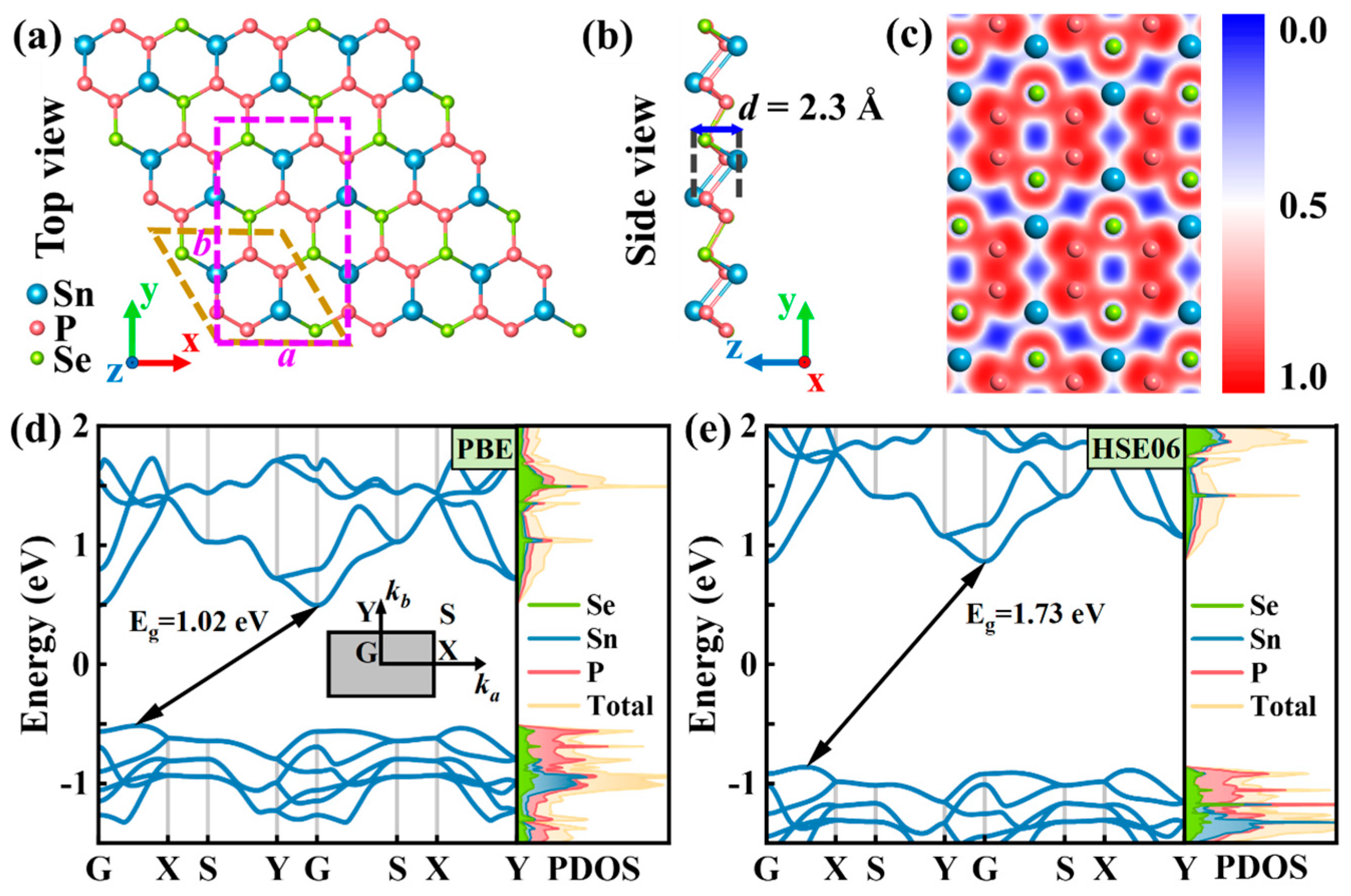
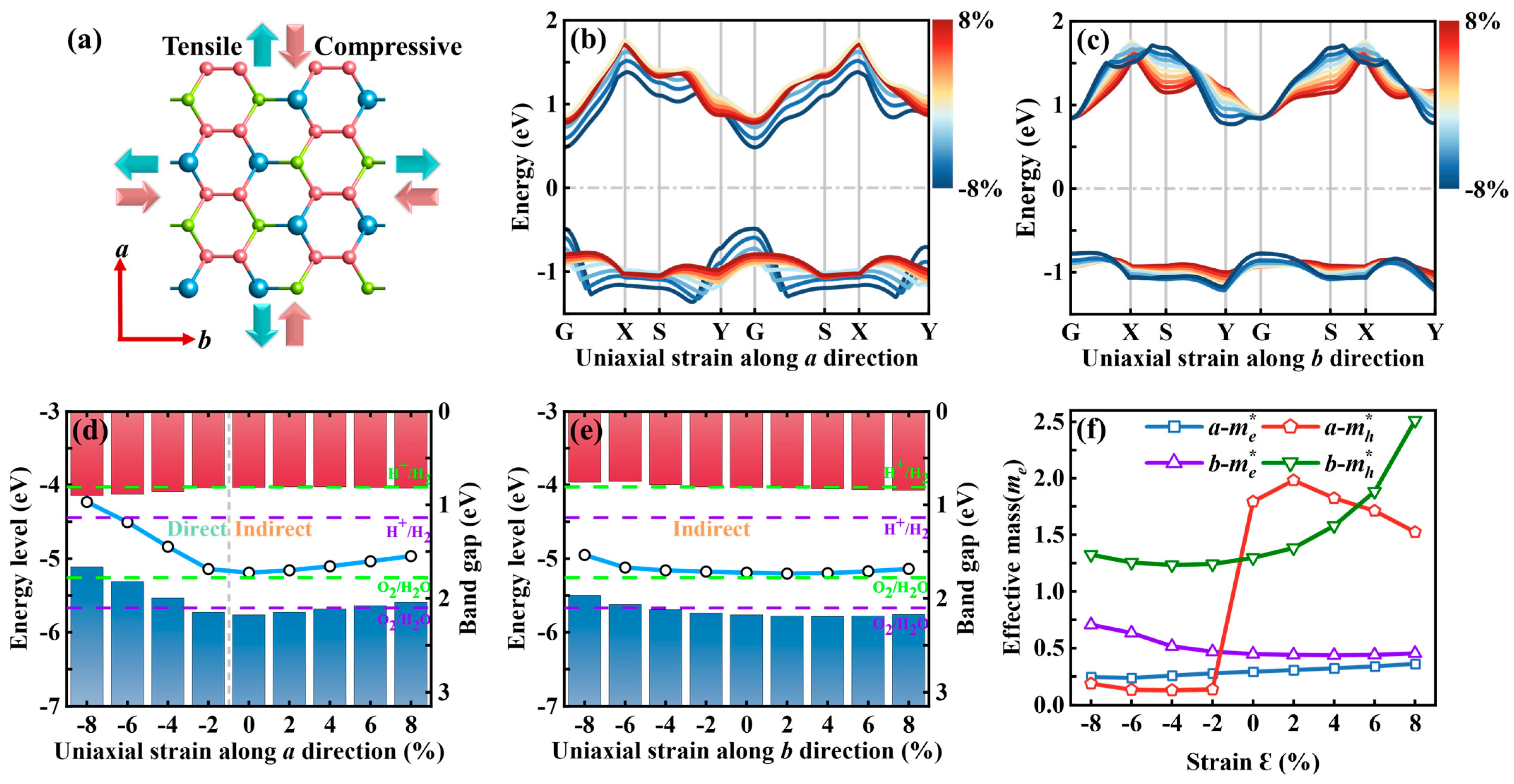
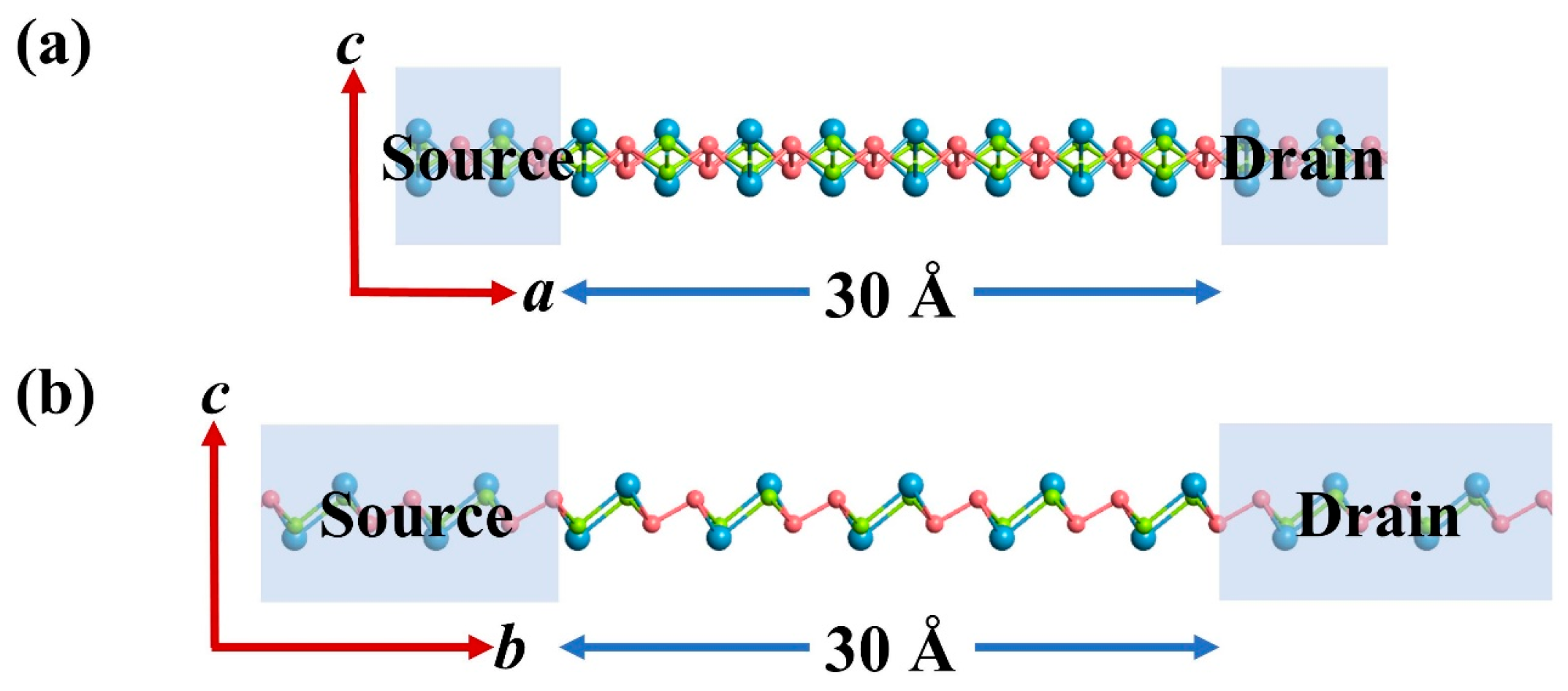
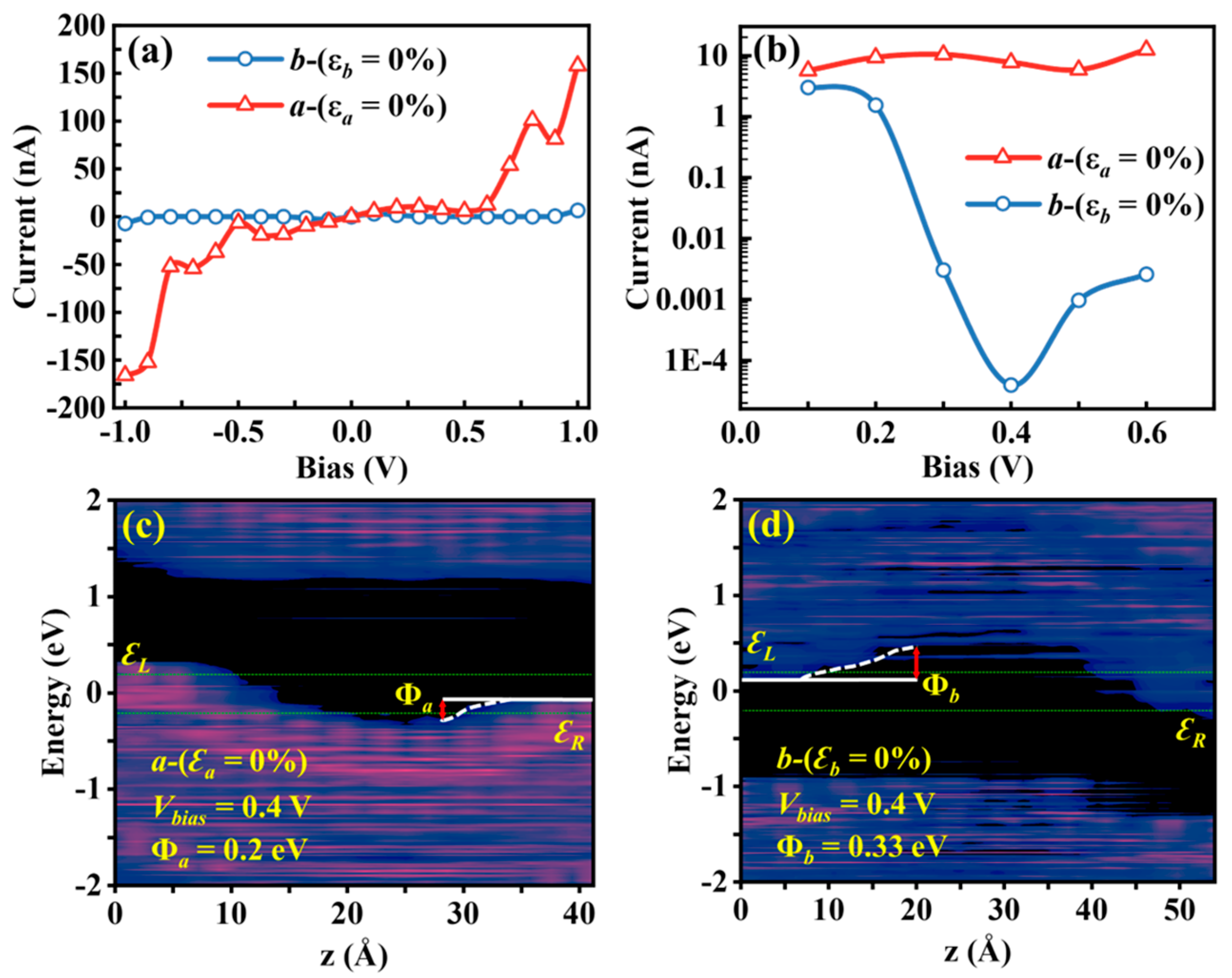


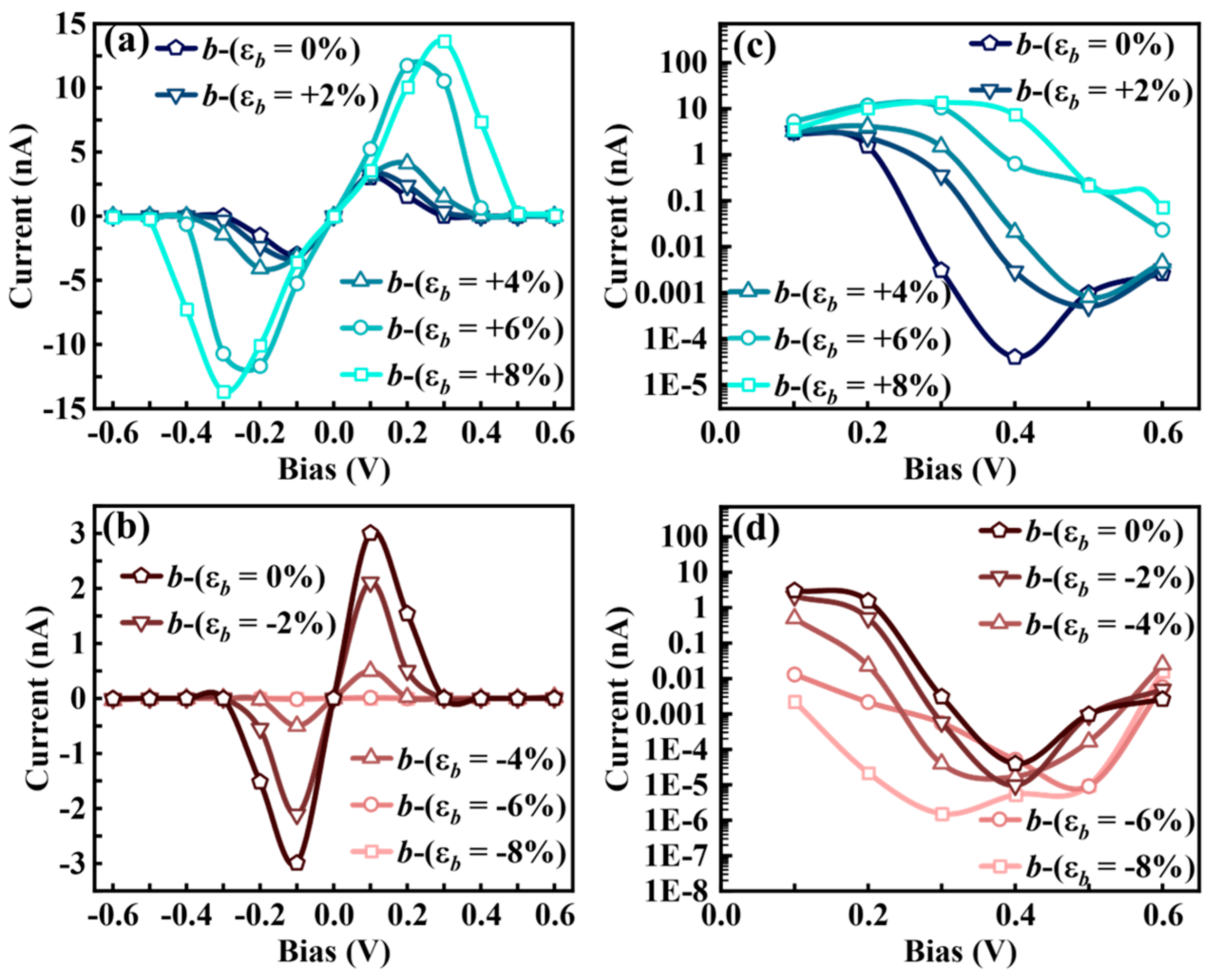
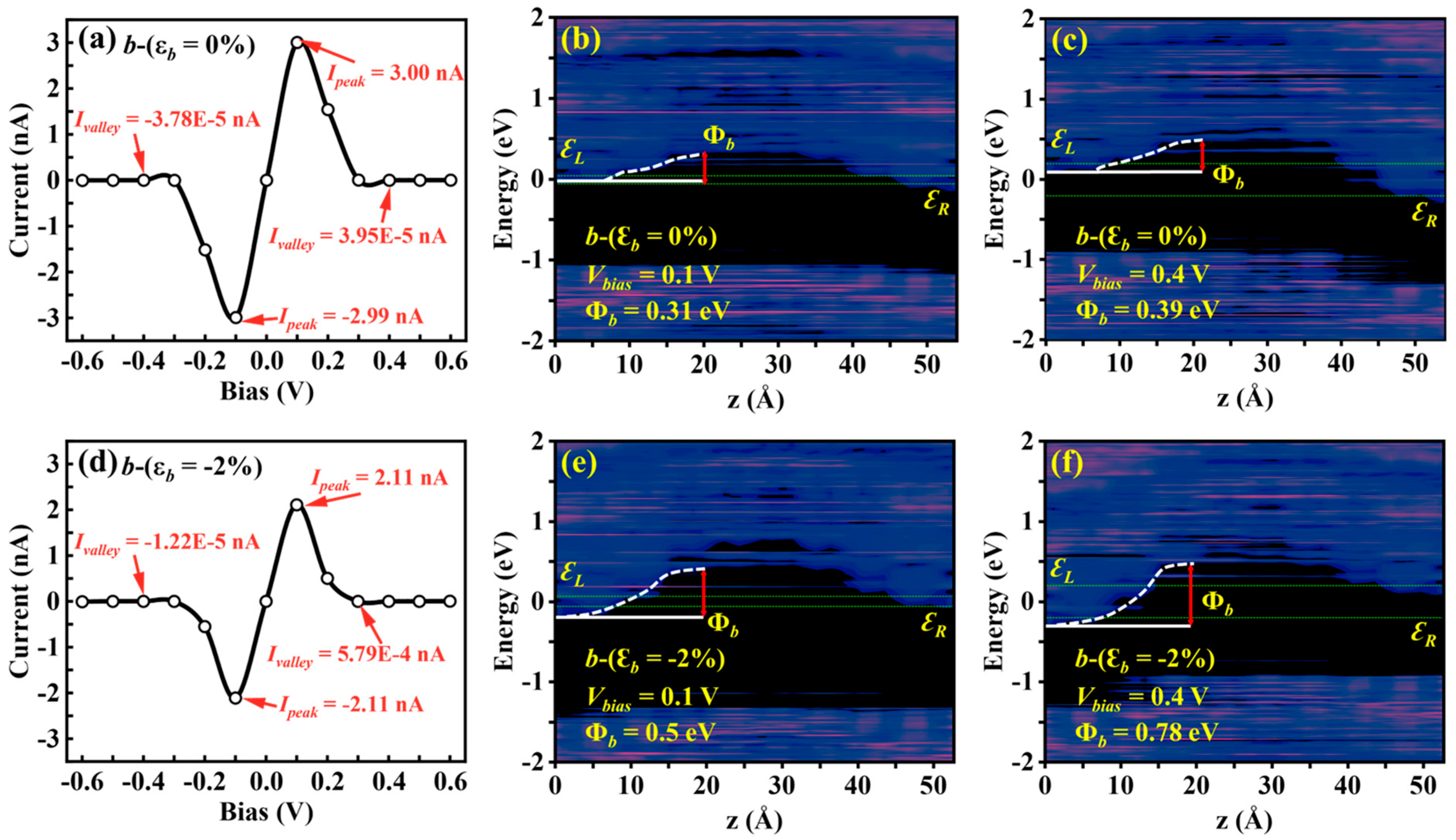


Disclaimer/Publisher’s Note: The statements, opinions and data contained in all publications are solely those of the individual author(s) and contributor(s) and not of MDPI and/or the editor(s). MDPI and/or the editor(s) disclaim responsibility for any injury to people or property resulting from any ideas, methods, instructions or products referred to in the content. |
© 2025 by the authors. Licensee MDPI, Basel, Switzerland. This article is an open access article distributed under the terms and conditions of the Creative Commons Attribution (CC BY) license (https://creativecommons.org/licenses/by/4.0/).
Share and Cite
Xu, H.; Xu, Y. Strain Engineering of Anisotropic Electronic, Transport, and Photoelectric Properties in Monolayer Sn2Se2P4. Nanomaterials 2025, 15, 679. https://doi.org/10.3390/nano15090679
Xu H, Xu Y. Strain Engineering of Anisotropic Electronic, Transport, and Photoelectric Properties in Monolayer Sn2Se2P4. Nanomaterials. 2025; 15(9):679. https://doi.org/10.3390/nano15090679
Chicago/Turabian StyleXu, Haowen, and Yuehua Xu. 2025. "Strain Engineering of Anisotropic Electronic, Transport, and Photoelectric Properties in Monolayer Sn2Se2P4" Nanomaterials 15, no. 9: 679. https://doi.org/10.3390/nano15090679
APA StyleXu, H., & Xu, Y. (2025). Strain Engineering of Anisotropic Electronic, Transport, and Photoelectric Properties in Monolayer Sn2Se2P4. Nanomaterials, 15(9), 679. https://doi.org/10.3390/nano15090679





